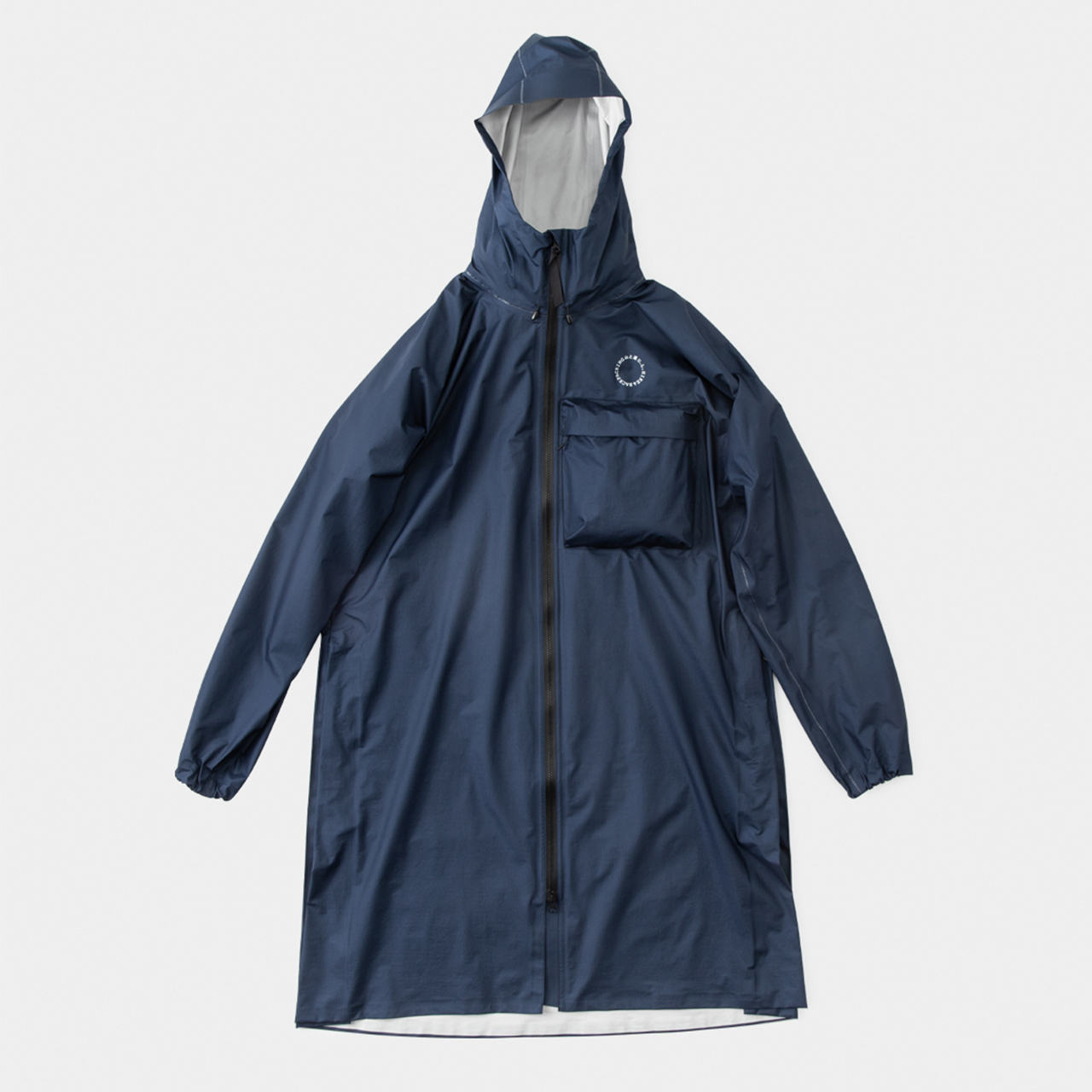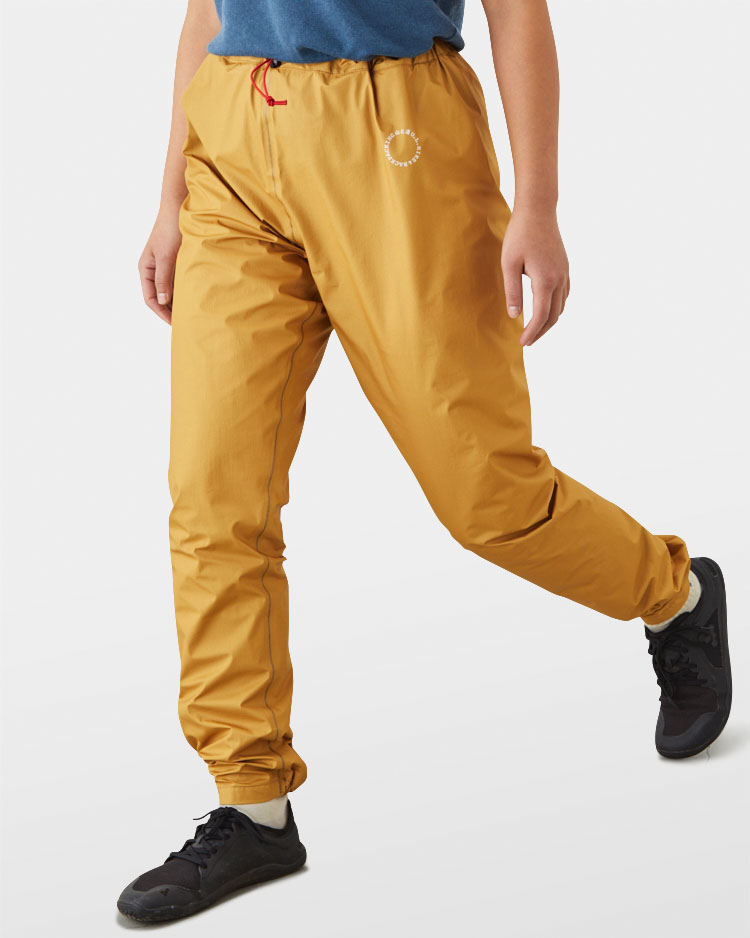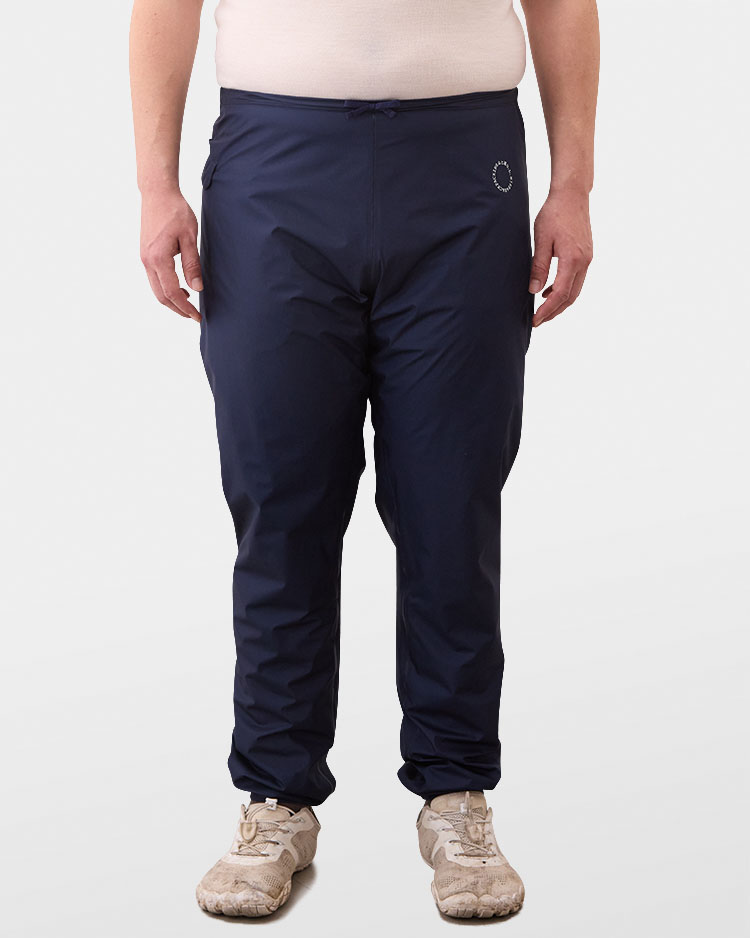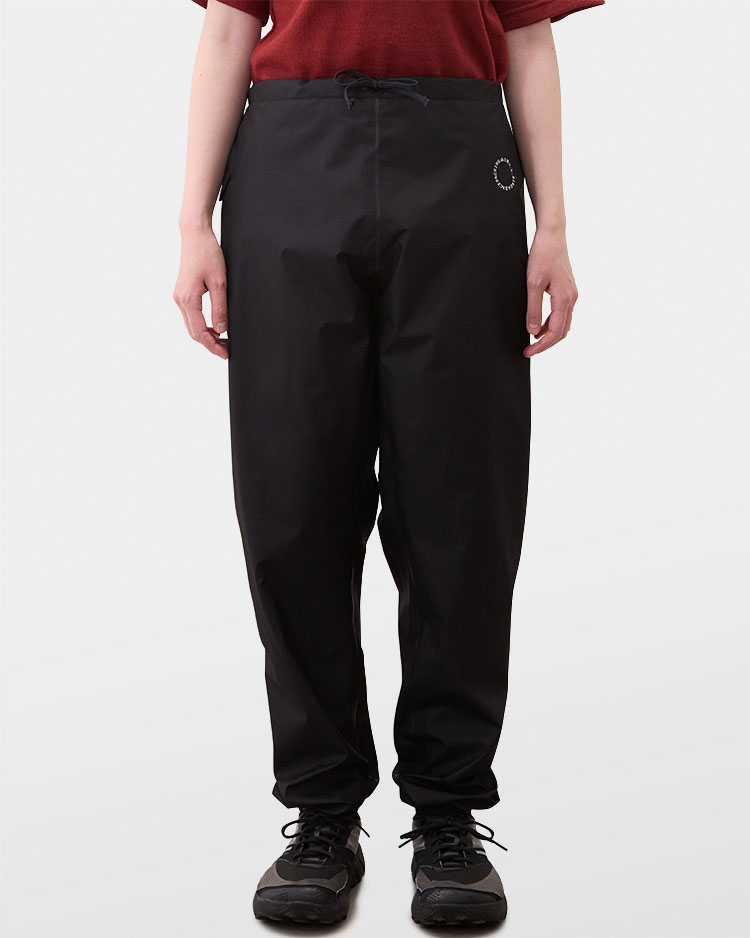85g (Size S)
94g (Size M)
99g (Size L)
104g (Size XL)
- Introduction
- Not just for rainy days
- Product Story
- Intriguing new gear
- Form and Function
- All-weather Activewear: A Novel Product Category
- Overwhelming Ventilation
- Incredibly lightweight at just 85g
- Advanced Ultrasonic Welding
- Simple and Comfortable
- UL All-weather Series
- Related Yamatomichi Journals
- Yamatomichi Lab Special Issue: All-weather Activewear #1-3
- Review
- Material
- Pertex Shield Air
- Size guide
- Notes before use
- Lifespan of the water repellency
- Instructions
- Care instructions
- Repair
Introduction
Not just for rainy days
When hiking a steep uphill, windy ridgeline, or in the pouring rain, this All-weather Activewear keeps you comfortable anytime, anywhere.
Our All-weather series, using the Pertex Shield Air, is significantly lighter than other conventional breathable moisture-permeable jackets and pants. The fabric’s superior breathability makes the jacket unbelievably comfortable, making it work as a windshell or as a rain jacket.
When hiking a steep uphill, windy ridgeline, or in the pouring rain, this All-weather Activewear keeps you comfortable anytime, anywhere.
Weighing just 85g (Size S), they are among the world’s lightest rain pants using a 3-layer nanofiber membrane. The slightly slim, streamlined design allows for easy movement, offering a light, breathable feel. And of course, they come with Yamatomichi’s signature smartphone pocket.
These aren’t just for rainy days—we encourage you to wear them even when the sun is out.
2025 Model Update
The waist drawcord has been updated to a flat strap, making it less likely to slip down even when carrying a smartphone or other items in the pockets.
Product Story
Intriguing new gear
The UL All-weather series is quite different from your regular rainwear.
It’s best to think of it as a new category of gear altogether. Some caution is needed when using, but if used right it will take you even further.

Makoto Fujiyama, wearing the Black color.
With proper use, it will bring you overwhelming comfort and joy on your next hike.
I first heard about Pertex Shield Air, the material adopted for the UL-All-weather series, about three years ago. At the time, we were conducting research on rainwear at the Yamatomichi Lab. Interested in our research results, Pertex contacted us and provided us with sample fabrics of the Pertex Shield Air before it was officially released.
Initially, I thought that with Pertex Shield Air I could make new rainwear that was simply lighter and more breathable than the NeoShell (an air/moisture-permeable waterproof fabric).
However, the potential for the fabric was far more profound than that. During a field test I conducted at Taisetsuzan Hokkaido at the end of August, I realized that there was a need to differentiate this amazing fabric from traditional rainwear.
There are no trees on the ridges of Taisetsuzan in Hokkaido, and no place to take refuge. In this environment, with strong winds and light rain, I wore a prototype jacket using Pertex Shield Air and was pleased with the comfort and dryness it provided in active situations. However, I noticed that my body heat was immediately ventilated outside during my breaks.
Rainwear is usually known to protect you from the wind and is able to somewhat retain body heat. The All-weather series is different. It is as if the jacket is telling you “Don’t stop moving!” We can’t deny the benefits it brings in terms of dryness, and breathability, but we also cannot deny the lack of heat retention when resting. In other words, it is difficult to keep warm with this garment alone, especially in bad weather.
To be honest, I was a bit worried. I thought that if the wearer used this fabric without knowing its flaws, it could be truly dangerous.
For ages, I have been wishing for rainwear that could be worn at all times, and rainwear that had a little bit more breathability. I went as far as thinking that fabrics that weren’t breathable were no good. But that was not the case. Excellent breathability will vent the heat out but will lead to less heat retention in bad weather. On the contrary, rainwear with high thermal insulation tends to trap heat and become stuffy during activities.
While it excites me that the gear I wanted to take shape, I also worried at times. I’ve come to realize that the Pertex Shield Pro, the fabric used for our UL Rain series, has a good balance of warmth and breathability.
But in the end, I decided to release this product because I was thrilled that the answer I had been seeking for many years had finally taken shape and because I truly felt from the bottom of my heart that this fabric would make very interesting gear.
Choosing the right gear may differ depending on its purpose. There is no doubt that this is a garment that active hikers and trail runners have been on the lookout for many years, but it may not be the best fit for those who are not looking to stay highly active while hiking.
To conclude, I could have used a lighter material, but since I decided to use the name “All-weather,” I wanted to maintain a certain level of durability and strength, as well as a sense of elasticity, so I was particular about the combination of outer and inner fabrics for the garment. Ultrasonic welding has also evolved.
At first glance, you may think, “What’s changed from the UL Rain series?”
But trust me, they are very different.
Form and Function
All-weather Activewear: A Novel Product Category
The UL All-weather series offers overwhelming breathability compared to conventional rainwear. It has evolved into a new product category we call “All-weather Activewear” equally suitable for sunny and rainy days.
Its excellent ventilation performance lets the heat out and keeps you dry when running or going uphill, even when normal rainwear is too humid and warm to wear. The 10,000mm water pressure resistance will protect you from getting wet in case of sudden rain.

Comparison with general mountaineering rainwear
The diagram below compares the UL All-weather series with typical mountaineering rainwear (assuming products weighing 200–300g that use waterproof-breathable membranes like Gore-Tex).
While standard rainwear provides excellent insulation, it often lacks breathability, causing heat buildup inside. In contrast, the UL All-weather series is lightweight and highly breathable, allowing excess heat to escape even during intense activities. However, this superior breathability can also mean feeling cold in strong winds, and the water resistance rating (10,000mm) is lower compared to conventional rainwear. For this reason, proper layering is essential when using the All-weather series, especially in harsher conditions.

Overwhelming Ventilation
What’s so special about the Pertex Shield Air? It’s a novel nanofiber fabric that is permeable not only by moisture but also by air. This air/moisture-permeability creates a truly unique kind of breathability.
We tested the breathability of the Pertex Shield Air of the UL All-weather series and the existing UL Rain Hoody (discontinued), the Pertex Shield fabric. The test method is as follows:
The test fabric is placed in the middle of the tester. The upper half of the tester has some water in it, while the lower half is empty (filled with air). When the lower half is pressurized by the pump, the fabric lets the air pass, and bubbles are created in the upper half. The more air that passes through, the more bubbles are created. The Pertex Shield with no air-permeability does not generate air bubbles. On the other hand, the Shield Air creates many air bubbles, indicating its high air-permeability.
Incredibly lightweight at just 85g
At 85g in size S, these rank among the lightest rain pants featuring a 3-layer nanofiber membrane.

Advanced Ultrasonic Welding
Usually, the stitching of the rainwear is seam-taped from the back to prevent water penetration. However, seam tape lacks durability, and water may seep through seams due to deterioration over time.
The UL All-weather Jacket adopts ultrasonic welding, the latest technology that melts and welds the fabrics together by the heat of ultrasonic vibration. This method creates no stitch holes with less damage to the fabric, minimizing the risk of water penetration from the seams due to deterioration with age.
Yamatomichi has teamed up with one of a few craftsmen and factories in Akita Prefecture that are capable of ultrasonic welding and is developing new technologies to make better products.
New technology allows the fabric to be layered and then welded together, making it even more durable, stronger, and waterproof than its predecessor, the UL Rain series (currently discontinued).
Simple and Comfortable
It has a sleek and slim silhouette with a squeezed hem, making it light, comfortable, and neat. It can be actively worn as wind pants during intense activities or 2nd layer for when not moving.

Smartphone Pocket
A smartphone pocket is added on the right hip of the pants for greater convenience.

UL All-weather Series
The UL All-weather series includes five models: the Pants, a zipperless Hoody, a longer Long Hoody, a Jacket with double zippers, and a long Coat with pockets and zippers. We’ve summarized the key features and recommended activities for each model below, so please take a look.
Related Yamatomichi Journals
Yamatomichi Lab Special Issue: All-weather Activewear #1-3
With the launch of the UL All-weather series, we created a special three-part feature in our JOURNALS series, Yamatomichi Lab.
This feature takes a deep dive into the technologies behind various waterproof-breathable fabrics, including Pertex Shield Air. It also includes real-world wear tests conducted at testing facilities, and a roundtable discussion with Tomoya Tsuchiya (Hikers Depot) and Kei Kuwabara (Run boys! Run girls!), exploring the current state of rainwear in the outdoor scene.
This series is not only a great resource for understanding the UL All-weather series but also an insightful look into the broader world of modern rainwear.
Review
Reviews from Yamatomichi staff sharing their firsthand experiences, highlighting the appeal and usability they felt while wearing the product.
These ultralight rain pants weigh almost the same as wind pants. For me, rain pants are something I rarely use. Unless it’s pouring heavily, I often leave my legs exposed and let them get wet. When I do wear rain pants, it’s usually not for warmth but because I’m worried about wet socks leading to blisters. That’s why I prefer something even lighter and more packable, making these pants my go-to choice. Unlike my colleague Hara, I did initially find the lack of ankle zippers a bit inconvenient. However, I agree with the reasoning—these pants are so comfortable that you don’t feel the need to take them off frequently.

Yamatomichi Main Researcher
In charge of research, including materials and the general outdoor market. After working for various design companies, Takahiro participated in the establishment of a marketing company. Currently involved in various research and data analysis. Also works on travel-related tasks such as operating a travel information site (tabinote.jp) and writing guide articles. His favorite style of hiking is walking for 2 days straight with no sleep. Occasionally participates in trail running races.
Rain pants are typically for wet weather, but as the name suggests, Yamatomichi's UL All-Weather Pants are versatile across various conditions.
They perform well in rain and strong winds but also excel in fair weather by preventing my lower body from overheating. My favorite use is at camp—after pitching my tent, I’ll put them on if it’s chilly and often sleep in them inside my sleeping bag.
Lighter than the Light 5-Pocket Pants, they’re easy to carry and work well as long pants. The soft fabric is comfortable enough to wear over shorts for sleeping without any discomfort. Unlike regular rain pants, which can trap heat poorly and feel cold, these pants transfer body heat effectively, making for a warm, comfortable night.
In the morning, they keep my legs dry when packing up in the dew, and once it warms up, I switch to shorts and continue hiking.
While they’re reasonably durable, the ultra-light fabric requires some care, like avoiding rough surfaces. Still, their versatility makes them much more than just rain pants.

Yamatomichi Kamakura Store Manager / Sales
Hidenori grew up in rural Hokkaido. After working for five years as a physical therapist in an orthopedic clinic, he decided to work as a mountain hut caretaker in the Northern Japanese Alps. In 2019, he embarked on a journey of walking the entire length of New Zealand’s “Te Araroa” long trail with his spouse, seeking to fully immerse themselves in nature. This experience led them to embrace ultralight hiking and his current goal is to research and adopt a hiking style that minimizes injuries and environmental impact, so that he can stay as an active hiker even when he ages.
Material
Pertex Shield Air
The Pertex Shield Air is a novel fabric developed by Pertex to further improve water pressure resistance, washing resistance, and overall quality from existing nanofiber membranes.
Nanofiber membranes are net-like structures made of extremely fine polyurethane (PU) fibers that are water repellent (hydrophobic). They have a sponge-like structure with many micropores, allowing the air and moisture to pass through. This air-permeability creates exceptional comfort within the clothes.

The Pertex Shield Air is much lighter than conventional nanofiber fabrics, with a weight of 50g/㎡ to 60g/㎡. For breathability and durability, our proprietary version of Shield Air has 15 denier nylon fabric (40 denier ripstop) as the outer layer and 7 denier nylon as the inner layer. This combination makes it much lighter and more breathable than other nanofiber-based, waterproof moisture-permeable fabrics.

Size guide
Size chart
| Size | XS | S | M | L | XL |
|---|---|---|---|---|---|
| Height (cm) | 150~161 | 159~167 | 165~175 | 173~180 | 178~185 |
| Weight (kg) | 42~53 | 51~61 | 59~69 | 67~78 | 76~85 |
| Waist (cm) | 60~70 | 68~80 | 74~84 | 82~92 | 90~94 |
Product dimensions

Uni: cm
| Size | XS | S | M | L | XL |
|---|---|---|---|---|---|
| Pants Length | 102 | 105.5 | 109 | 112.5 | 115 |
| Inseam | 75 | 78 | 81 | 84 | 86 |
| Waist | 66 | 71 | 76 | 81 | 86 |
| Hip | 53.5 | 55.5 | 58.5 | 61.5 | 64 |
| Hemline | 10.5 | 11.5 | 12.5 | 13.5 | 14.5 |
Fitting
Notes before use
- The UL All-weather series is our ultralight waterproof rainwear made of ultrathin, moisture-permeable fabric. Please handle it with care as it can be torn or ripped when rubbed against rocks or scratched by spiky branches.
- The UL All-weather series is comfortable when you are on the move in a relatively warm environment. However, it is less warm than normal water-resistant jackets or winter hard shells so we strongly recommend you wear a merino wool base layer to keep you warm especially when severe weather is to be expected.
- To maximize moisture-permeability, after-use care is necessary. The performances of the membrane, the performances of the facing and lining can be impaired by dirt, sweat, skin oil, or other substances. Please follow the washing instructions of each product to properly wash, dry, and keep it clean.
- When the surface water-repellent coating is hindered, so is moisture-permeability. If you notice the water repellency has been weakened, tumble dry at low temperature or apply heat by the hairdryer to restore the water repellency. Please note that initial water repellency is meant to be weakened by repeated washing. Use water repellents for regular care.
- The UL All-weather series uses ultralight, thin microporous fabric. Vaseline, insect repellent, and ethanol-containing substances such as hair creams, cosmetics, and sunscreens may stain the fabric. They may also hinder the water-permeability of the fabric.
Lifespan of the water repellency
Water repellency tends to last longer on thicker fabrics, as they absorb more of the water-repellent treatment. However, the UL All-weather series uses the thinnest, most breathable outer fabric possible to prioritize lightness and ventilation. While the garments are treated to ensure sufficient water repellency at the time of shipment, the durability of that repellency is lower compared to thicker waterproof-breathable materials.
When the water-repellent treatment is working properly, moisture beads up and rolls off the surface. But as the treatment wears off, water can spread across the fabric, forming a thin film that reduces breathability. This can cause the inside of the garment to feel damp from trapped moisture or condensation.
If you notice a decline in water repellency, you can revive it by applying heat—using a dryer or hairdryer after washing. If water repellency still doesn’t recover, we recommend reapplying a commercially available water-repellent treatment.
Instructions
Care instructions
- Machine wash, gentle at 30°C.
- Use rainwear-specific detergent or a neutral detergent that does not contain bleaching, softening, or brightening agents.
- Wash separately or use a laundry net bag.
- Apply detergent diluted with water and wash with a soft sponge if badly stained. Do not scrub the surface joints or the seam tape on the back.
- If necessary, tumble dry the garment at a upper limit of 60°C to restore water repellency.
- Do not bleach and do not use fabric softener.
- Iron on low. Do not steam.
- Do not dry-clean.
- Vaseline, insect repellent, and ethanol-containing substances such as hair creams, cosmetics and sunscreens may stain the fabric. They may also hinder the water-permeability of the fabric. For removal methods, please refer to the our Journal; #2 – Removing stains from rainwear.
Care Instruction Page
For more detailed washing, drying and water repellent care instructions, visit our SUPPORT Page. With proper care you can prolong the funtionality of the product.
Payment
- We only accept payment by credit card. We currently do not accept payment via bank transfer from overseas accounts.
- We accept the following Credit Cards: Visa, Master, American Express, and JCB.
- To download your receipt, please click the link included in the Dispatch Notice, which we will send by email as soon as the items are dispatched.
- Bank transfer is only availble for those that own a Japanese bank account.
Delivery
- Order Confirmation will be sent after the order.
- The items will be dispatched within 3 days after the payment is confirmed.
- The dispatch notice will be sent by email as soon as the items are dispatched.
- The delivery may be delayed by unforeseeable reasons such as natural disasters and other logistics issues. We appreciate your patience and understanding.
- We cannot ship multiple orders in one package due to how our delivery system is currently set up.
- We will ship to regions in North America, Oceania, and Europe (excluding Russia) via DHL. For regions in Asia, the Middle East, Central and South America, Africa, and Russia, we use EMS (International Express Mail Service) for shipping.
- Shipping fees and delivery times vary depending on the shipping destination as well as the size and weight of the items.
Size Exchange
- Overseas customers who need to change the size of their order, should note that the time needed for shipping will vary greatly depending on your country of residence.
- We only accept exchanges when the item is unused (except for fitting).
- If you wish to exchange the size of the item, please contact us within seven days of receiving your order.
- Exchanges can only be made for the same color in a different size.
- If the size you wish is out of stock, we will suggest a different color.
- If the product is out of stock, we may simply have to ship the item back to you.
- All shipping costs to be carried by the customer.
- We will only send the exchanged item to you, upon receipt of return shipping cost via PayPal.
- Please be aware that some countries charge customs duties depending on the price of the item.
- We are unable to answer any questions on local customs. Please contact your local customs bureau.
Repair
We accept repairs for all of our Yamatomichi products. For inquiries on repair services including patching the holes, repairing with extra components, or fixing the items damaged over time, please feel free to contact us from the “Repair” section of the SUPPORT page.

























































